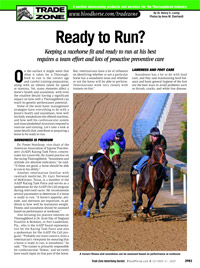Trade Zone: Transportation Tips - Click Here to Download PDF
 By Dr. Nancy S. Loving
By Dr. Nancy S. Loving
On the surface it might seem that what it takes for a Thoroughbred to run is the correct age and careful training preparation, along with an inborn talent for speed or stamina. Yet, many elements affect a horse’s health and soundness, with even the smallest details having a significant impact on how well a Thoroughbred can reach its genetic performance potential. Some of the most basic management strategies have everything to do with a horse’s health and soundness, how well his body metabolizes the offered nutrition, and how well his cardiovascular system and musculoskeletal structures respond to exercise and training. Let’s take a look at some details that contribute to preparing a horse to be ready to run.
Soundness is Premium
Dr. Foster Northrop, vice chair of the American Association of Equine Practitioners (AAEP) Racing Task Force, concentrates his Louisville, Ky.-based practice on the racing Thoroughbred. “Soundness and attitude are absolute indicators,” he said. “If these are good, a horse should be able to run to his ability.”
Another veterinarian familiar with racetrack medicine, Dr. Gary Norwood of McKinney, Texas, is a member of the AAEP Racing Task Force and serves as a spokesman for the AAEP On Call program during televised races. He recommends several parameters to determine if a horse is ready to run: “A horse’s appetite, attitude, and alertness are important, in addition to how well he maintains weight. Fitness and soundness should be assessed based on performance at workouts.”
Also focusing his practice interests on Thoroughbred is Dr. Scott Hay of Teigland Franklin & Brokken, in Fort Lauderdale, Fla., who is the AAEP board representative for the Racing Task Force and also a spokesman for the AAEP On Call program. “Probably our main concern, from a veterinarian’s viewpoint for ensuring that a horse is ready to run, is soundness,” he said. “The trainer is primarily responsible for cardiovascular ‘fitness,’ and we rarely have much input on that part of the horse.
To continue reading, click the "Download" button at the bottom of this page.
Sponsors:
Dandy Products (www.dandyproductsinc.com)
Doc’s Equine Products (www.ocdpellets.com)
Equiade Products (www.equiade.com)
Farrier Products Distribution (www.farrierproducts.com)
Life Data Labs, Inc. (www.lifedatalabs.com)
Luitpold Pharmaceuticals (www.luitpold.com)
The Pond Lady (www.thepondlady.com)
Archives:
Feeding For the Ages - September 19, 2009
Transportation Tips - September 5, 2009
Disease Control Yearly Planner - August 8, 2009
Foot Flops & Fixes - July 25, 2009
Get Ready - June 26, 2009
Therapy For Thoroughbreds - May 5, 2009
Dirt or Synthetic - Which is Safer? - April 25, 2009
AAEP: Focus on Horse Health News - March 21, 2009
Infectious Disease at the AAEP Convention - February 21, 2009
When Foaling Goes Wrong - December 6, 2008
Feeding the Pregnant Mare - November 15, 2008
Broodmare Vaccinations - November 1, 2008
Transport Stress in Horses - October 18, 2008
View more...




